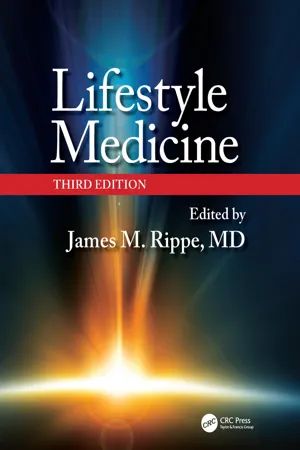
Lifestyle Medicine, Third Edition
James M. Rippe, James M. Rippe
- 1,435 pages
- English
- ePUB (adapté aux mobiles)
- Disponible sur iOS et Android
Lifestyle Medicine, Third Edition
James M. Rippe, James M. Rippe
À propos de ce livre
The field of lifestyle medicine, which is the study of how daily habits and actions impact on both short- and long-term health and quality of life, continues to expand globally. The scientific and medical literature that supports the success of these lifestyle habits and actions is now overwhelming. Thousands of studies provide evidence that regular physical activity, maintenance of a health body weight, following sound nutritional practices, stress reduction, and other good practices all profoundly impact both health and quality of life.
Following its predecessors, Lifestyle Medicine, Third Edition, is edited by lifestyle medicine pioneer, cardiologist Dr. James Rippe. This edition has been thoroughly updated and represents the expert opinions of 20 section editors as well as more than 150 expert chapter authors whose knowledge span all aspects of this emerging discipline. Topics cover lifestyle medicine practices including regular physical activity, proper nutrition, and weight management. These principles are applied to the prevention and or treatment of a wide variety of chronic conditions ranging from heart disease and diabetes to cancer, mental health, addiction, and injury prevention.
This book serves as evidence base for individuals who wish to practice lifestyle medicine or incorporate some of its principles into either general medicine or subspecialty practice. It provides valuable information to healthcare workers in the fields of nutrition, exercise physiology, psychology, behavioral medicine, health promotion, and public policy where lifestyle medicine principles play an ever-increasing role.
Foire aux questions
Informations
Part
I
Lifestyle Management and Prevention of Cardiovascular Disease
James M. Rippe, MD
Chapter
1
The Rationale for Intervention to Reduce the Risk of Cardiovascular Disease
James M. Rippe, MD and Theodore J. Angelopoulos PhD, MPH
Key Points
- Cardiovascular Disease (CVD) remains the leading cause of death and disability in the United States and worldwide.
- Multiple risk factors increase the risk of CVD. Many of these risk factors have a significant lifestyle component.
- There has been a significant decrease in CVD mortality over the past four decades. Half of this decrease is due to lower risk factors. Increases in several risk factors, however, including obesity and diabetes, threaten to wipe out gains in all other risk factors.
- If individuals used the following four positive daily lifestyle measures, the prevalence of CVD could be decreased over 80% and the prevalence of diabetes could be decreased over 90%. The measures are1 maintain proper weight,2 do not smoke cigarettes,3 engage in regular physical activity, and4 follow sound nutritional patterns.
- The American Heart Association (AHA) has recommended an emphasis on “primordial prevention,” which means lowering the likelihood of developing risk factors in the first place.
- Physician visits are an ideal opportunity to stress the importance of lifestyle habits and practices to reduce the risk of cardiovascular disease.